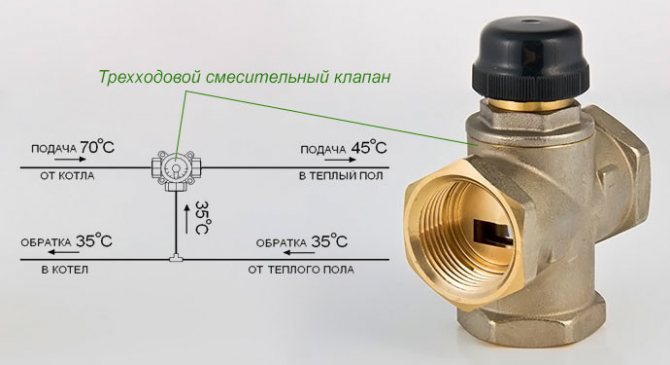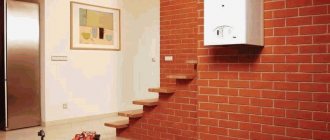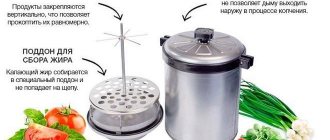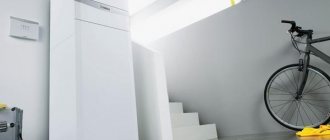Gas preservation of hot water boilers
Argon reducer.
Let us first analyze the preservation of boilers with gas. The bottom line is that gas is pumped into the heater, which, in contact with wet metal surfaces, does not start oxidation processes, that is, corrosion. The gas completely squeezes out the air, which contains oxygen. Can be used:
The instructions for the preservation of hot water boilers have a clear algorithm of actions. First you need to fill the heater with deaerated water - this is water from which air is removed. But in principle, you can also fill in ordinary water. Then a gas cylinder is connected to the upper pipe of the heater.
The pressure in the gas cylinder is enormous, about 140 atmospheres. If you give such pressure directly to the heating boiler, it will burst. Therefore, a reducer is screwed onto the cylinder.
It has two pressure gauges. One pressure gauge shows the pressure that comes from the cylinder, and the second pressure gauge shows the pressure that is supplied to the boiler. The required pressure can be set on the reducer and when this value is reached, the gas supply from the cylinder stops. Thus, it is possible not only to safely fill the boiler with gas, but also to build up the pressure to the required value (0.013 MPa is recommended).
The process goes something like this:
- gas slowly squeezes water out of the boiler (the lower branch pipe must be open);
- after all the liquid has left, the lower branch pipe is closed;
- when the pressure in the boiler reaches 0.013 MPa, the gas stops flowing;
- the upper branch pipe to which the reducer is connected is blocked.
From time to time it is necessary to check the gas pressure and, if necessary, make adjustments. The main thing is to prevent air from entering the boiler.
Preparation for storage of boilers
Gas boilers (steam and hot water) are disconnected from the main gas and water pipelines with special plugs that cool completely, after which water is removed from them through the drainage systems. Then the boiler equipment repair specialists proceed to the internal cleaning of the boilers from scale. Scale significantly reduces the shelf life of boilers and reduces their efficiency by an average of 40%, therefore, the internal elements of the boilers are thoroughly cleaned annually. Despite the fact that boiler water undergoes preliminary chemical treatment to remove heavy calcium and magnesium salts, during the heating season a significant part of these salts is deposited on the internal heating surfaces of boiler units.
With the mechanical cleaning method, the inner surfaces of the drums and collectors are first cleaned, and then the wall tubes. Cleaning is carried out using blunt chisels, as well as special heads powered by an electric motor according to the principle of a drill.
In places inaccessible for mechanical cleaning, manual cleaning is carried out, for which special scrapers, wire brushes, abrasive tools and blunt mild steel hammers are used. During manual cleaning, it is forbidden to use chisels and other sharp tools in order to avoid disturbing the metal surface.
The fastest and most effective cleaning method is chemical, which, in turn, is divided into acidic and alkaline. The specialists of the boiler house carry out alkaline cleaning independently, using soda ash or caustic soda. Acid cleaning is carried out by a representative of a special organization. In this case, solutions of hydrochloric or sulfuric acid are used.
Methods for preserving boilers
Preservation is necessary * to prevent the corrosion process. The preservation of boilers for the summer period can be done by any of four methods:
- wet;
- dry;
- gas;
- overpressure method.
When preserving boilers using the wet method, the boilers are filled with a special liquid that forms a protective film on the inner heating surfaces, which prevents oxygen penetration.
With the dry method, water is removed from the boilers, and stainless steel trays are installed inside the drums and collectors, which are filled with desiccants (granular calcium chloride or quicklime). The boilers are then sealed.
The gas method involves filling the boilers with any inert gas, which also prevents corrosion.
The overpressure method is used in cases where boilers need to be shut down for a short period of time (up to 10 days). In all other cases, the first three methods are used.
Observing the rules for cleaning and preserving boiler equipment during the summer period, you can achieve high efficiency of boilers during the heating season, as well as significantly reduce the cost of repairing them.
*) excerpt from PUBE:
Wet method for heating conservation
The wet method is suitable for both the preservation of boilers and the heating system as a whole. The method consists in filling the circuit with a special liquid that will prevent the metal from rusting. If the house is not heated at all and there is a risk of freezing, then only antifreeze (non-freezing liquids based on propylene glycol) can be used as a conservation liquid. Concentrates do not freeze even at -60, but they thicken strongly. They can be diluted to the desired consistency, thereby adjusting the minimum operating temperature. The disadvantage of antifreezes is that they are expensive, they dry rubber, they have a high degree of fluidity, and when overheated they turn into acid.
If you do not plan to use the Buderus gas boiler for several months, then it must be preserved.
The same applies to solid fuel boilers Buderus. According to reviews, this significantly prolongs their life.
If you need to preserve the boiler and there is no risk that the liquid in it will freeze, then in addition to antifreeze, you can use water with the addition of sodium sulfate. Its concentration should be at least 10 g / l. After that, the liquid is heated to remove air from it and all the pipes are clogged. The liquid is pumped using a pressure pump. They are different: manual, automatic, household and professional. We have already written about how to fill the heating system.
Stopping gas boilers for the summer season
After the end of the heating season in gas boiler houses, a period of repair, cleaning and conservation of boiler units and auxiliary boiler equipment begins.
Gas boilers (steam and hot water) are disconnected from the main gas and water pipelines with special plugs that cool completely, after which water is removed from them through the drainage systems. Then the boiler equipment repair specialists proceed to the internal cleaning of the boilers from scale. Scale significantly reduces the shelf life of boilers and reduces their efficiency by an average of 40%, therefore, the internal elements of the boilers are thoroughly cleaned annually. Despite the fact that boiler water undergoes preliminary chemical treatment to remove heavy calcium and magnesium salts, during the heating season a significant part of these salts is deposited on the internal heating surfaces of boiler units.
There are 3 ways to descale boilers:
- mechanical;
- manual;
- chemical.
With the mechanical cleaning method, the inner surfaces of the drums and collectors are first cleaned, and then the wall tubes.Cleaning is carried out using blunt chisels, as well as special heads powered by an electric motor according to the principle of a drill.
In places inaccessible for mechanical cleaning, manual cleaning is carried out, for which special scrapers, wire brushes, abrasive tools and blunt mild steel hammers are used. During manual cleaning, it is forbidden to use chisels and other sharp tools in order to avoid disturbing the metal surface.
The fastest and most effective cleaning method is chemical, which, in turn, is divided into acidic and alkaline. The specialists of the boiler house carry out alkaline cleaning independently, using soda ash or caustic soda. Acid cleaning is carried out by a representative of a special organization. In this case, solutions of hydrochloric or sulfuric acid are used.
After cleaning the boilers from scale and subsequent rinsing of their inner surfaces, the boilers are preserved. This is necessary to prevent the corrosion process. The preservation of boilers for the summer period can be done by any of four methods:
- wet;
- dry;
- gas;
- overpressure method.
When preserving boilers using the wet method, the boilers are filled with a special liquid that forms a protective film on the inner heating surfaces, which prevents oxygen penetration.
With the dry method, water is removed from the boilers, and stainless steel trays are installed inside the drums and collectors, which are filled with desiccants (granular calcium chloride or quicklime). The boilers are then sealed.
The gas method involves filling the boilers with any inert gas, which also prevents corrosion.
The overpressure method is used in cases where boilers need to be shut down for a short period of time (up to 10 days). In all other cases, the first three methods are used.
Observing the rules for cleaning and preserving boiler equipment during the summer period, you can achieve high efficiency of boilers during the heating season, as well as significantly reduce the cost of repairing them.
Dry method of preserving water heaters
Dry preservation of the boiler room gives the same high guarantees of equipment safety as the above methods. The essence of the matter is to completely dry the internal channels from moisture. This can be done in several ways:
- blow through with a strong pressure of warm air;
- evaporate moisture.
In the Russian Federation, the Dakon boiler has gained prestige, therefore, its sales are constantly growing.
In Italian gas boilers Ferroli, malfunctions occur only in the event of improper operation.
You can evaporate moisture by turning on the burner or lighting a flame in the furnace of an empty (no liquid) boiler. It is important that the flame is very slow so that the heat exchanger does not burn out. Air remains in the channels of the heater, and moisture is always present in it in the form of steam. This moisture can condense under certain conditions. The presence of moisture in the air, although slowly, still leads to the destruction of the metal. Therefore, it is necessary to bookmark the moisture-absorbing substance. For this, granular potassium chloride or quicklime is suitable. The moisture-absorbing powders need to be changed periodically (every two months).
5.6. PREVENTION OF CORROSION AND PRESERVATION OF STEAM BOILERS
Prevention of corrosion by creating a protective magnetite film. The types and nature of corrosion of boiler heating surfaces are discussed in detail in 3.2.
The main method of protecting pipe systems of boilers from corrosion is the creation and preservation of a protective oxide film (passivation) on the metal surface from the side of the circulating water.The best protective properties are possessed by the Fe304 magnetite film, which prevents the penetration of oxygen and hydrogen to the metal, as well as the transition of metal corrosion products to water. The passivation of the boiler metal is achieved by treatment with Trilon B solutions. The method is based on the process of magnetite formation during thermal decomposition of iron complexates on the surface of boiler steels.
The passivation of boiler metal with chelating agents is usually carried out in two stages.
I. The heating surfaces are being prepared for the creation of a protective film and the formation of soluble complexonates in water. The dosage of Trilon B in a steam boiler should provide a solution concentration in the boiler water of 200 mg / l at a water temperature in the boiler of 140 ... 160 ° C (pressure in the steam-water drum is 0.4 ... 0.6 MPa). The holding time of the boiler at the parameters of stage I is 1 ... 1.5 h. At the end of the stage, the concentration of free complexonate in the boiler water must be at least 30 mg / l.
II. According to the operating instructions, the boiler is fired up until the operating pressure is created. It is desirable to maintain this pressure for 1 ... 1.5 hours and then put the boiler into operation. At this stage, starting from a temperature of 250 ° C and above, the process of thermal decomposition of iron complexonates occurs with the formation of a thin, uniform, durable layer of magnetite Fe304 on the surface of the boiler metal. A particularly strong magnetite film forms on the most stressed heating surfaces, its high corrosion resistance is manifested even in the presence of a high oxygen concentration in the boiler water. The protective film dramatically reduces iron oxide scale formation.
Preservation of boilers during decommissioning. Boilers taken out of operation for a period exceeding 24 hours must be mothballed to prevent corrosion. To prevent parking corrosion of internal surfaces, three methods of boiler storage (conservation) are used: “wet”, “dry” and “gas”.
Wet storage is used when the boiler is preserved for a period not exceeding 30 days. In wet storage, the boiler, superheater and eco-maiser are completely filled with water. To do this, you must use deaerated water. To preserve the protective film on the metal surface, it is necessary to maintain pH> 7 in water. For this purpose, trisodium phosphate is introduced into the boiler in an amount that provides a base number within 100 mg / l of NaOH.
In the absence of deaerated water, the boiler filling water must be heated to the boiling point to remove dissolved oxygen from it. To do this, briefly turn on the nozzle with the air valves open. When the water temperature in the boiler water header and in the lower superheater header reaches 100 ° C, close the air valves and connect the boiler and superheater to the pressure tank. The pressure tank serves to compensate for possible water leaks through leaks in the fittings, as well as due to a decrease in the volume of water in the boiler when it cools. Installation of a pressure tank above the upper point of the boiler ensures that a small overpressure is maintained, which prevents atmospheric air from entering the boiler.
The dry method is used when the boiler is stored for no more than two years. In dry storage, water is removed from the boiler, economizer and superheater, and the boiler is cleaned from the side of water and gases. Further, the inner surfaces of the boiler are dried by ventilation or by installing braziers with burning charcoal. After that, metal trays with moisture absorbers are installed in all collectors and the boiler is carefully sealed.
The following can be used as dehumidifiers: CaO quicklime at the rate of 2 kg per 1 m3 of volume; calcium chloride CaCl at the rate of 0.5 kg per 1 m3 of volume (use is allowed only in the absence of free chlorine, which is established on the basis of chemical analysis); silica gel at the rate of 4 kg per 1 m3 of volume (pre-calcined in an oven at a temperature of 150 ... 170 ° C for 3 ... 4 hours).
A boiler put into dry storage should be required at least
Open once every 3 months for inspection and replacement of desiccants.
The gas storage method has found wide application in stationary power engineering when decommissioning boilers.In this method, the boiler is emptied of water and filled with gaseous ammonia, which dissolves in the moisture film covering the inner surfaces of the boiler and gives it an alkaline reaction. Ammonia filling the internal volume sharply reduces the partial pressure of oxygen and, accordingly, its concentration in moisture. During storage, a slight excess ammonia pressure is maintained in the boiler.
When the boiler is inactive, the outer surfaces of pipes, collectors, etc. can also undergo corrosive damage. Therefore, the outer surfaces of the pipes must be thoroughly cleaned and covered with hot dehydrated low-sulfur fuel oil. Headers, casing and other parts of the boiler that are not exposed to flue gases should be painted with red lead or silver. The chimney must be covered if it is not connected to another operating boiler.
Technical execution of conservation
The whole procedure consists of three stages. The first stage removes all kinds of contaminants from the surfaces of the equipment, as well as traces of corrosion. If necessary and technically feasible, repair operations can also take place. This stage is completed by measures for surface degreasing, passivation and drying. The next stage involves processing with protective equipment, which are selected based on the individual requirements of the operation of the technical equipment. For example, preservation of boilers may involve treatment with high-temperature compounds, which in the future will provide the structure with optimal resistance to high temperatures. Versatile treatments include anti-corrosion powders and a liquid inhibitor. The final stage involves
Preservation of steam boilers: scheme | Teplomonster
A feature of the state of the energy sector today is that the number of shutdowns and downtime of boilers has increased at heating plants, this is due to a change in the mode of energy consumption and heat supply. The equipment is reserved for an indefinite period.
When the boiler is shut down, the pressure of the medium decreases to atmospheric, there is a possibility of moisture and air entering it, as a result, the boilers are subject to corrosion, which is considered dangerous, since there is a possibility of damage to all heating equipment, including pipelines.
Therefore, at the moment, the issue of conservation is especially relevant, and the development of technologies in this regard is progressing.
Solid fuel boiler diagram.
Thanks to the protection against corrosion formed during downtime, the working condition of the equipment is preserved, the costs of its repair and restoration are reduced, the technical and economic indicators of the operation of thermal power plants are maintained, and production costs are reduced.
There are several ways to preserve boilers:
- gas preservation method;
- wet preservation method;
- method of applying excess pressure;
- dry preservation method.




















